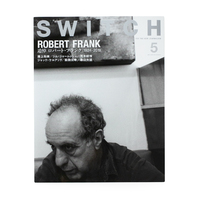Robert FRANK
Robert Frank’s restless, gritty, melancholic vision marked him as an astute documentarian of the postwar American landscape. Born into a German-Jewish family in Zurich in 1924, he developed an interest in photography at an early age and apprenticed with several photographers in his teens. In his early twenties his intrepid nature brought him to America, in 1947, where he found work as a commercial photographer, most notably at Harper's Bazaar under Alexey Brodovitch’s highly influential editorial vision. He soon left this relatively stable position for an itinerant life. At one point he served as an assistant to Walker Evans, whose photobook American Photographs (1938) set a precedent for Frank’s subsequent accomplishments. Bill Brandt’s A Night in London (1938) and André Kertész’s Day of Paris (1945) are other key books that helped him formulate his own point of view.
The publication of Frank’s photobook The Americans, first released in France in 1959 and subsequently printed stateside in 1960, caused nothing short of a revolution among photographers and documentarians. Shortly after its release, Popular Photography magazine published editorial reactions. One critic lamented, “Ugliness can be shocking, it can have impact—like a man spitting in your face: but it can also be given beauty by a sensitive photographer. Frank is sensitive, but apparently he is without love. There is no pity in his images. They are images of hate and hopelessness, of desolation and preoccupation with death. They are images of an America seen by a joyless man who hates the country of his adoption.”1 Another editor countered, “The fact is simply that he feels strongly about some of the things he sees in his adopted country, and wants to call them to our attention. He does it superbly.”2
In a country that was not his own, Frank assumed the unique position of an outsider and voyeur who unobtrusively captured the tensions of the geographic, economic, racial, and religious diversity of the US. After receiving a Guggenheim Fellowship in 1954, he made numerous cross-country car trips over a period of 10 months, ultimately logging 10,000 miles. He used a handheld camera to present a picture of the US that was provocatively out of sync with the insistent optimism that often characterized Americans' postwar sense of self. The 83 photographs comprising The Americans record cars, jukeboxes, bureaucracy, leisure, youth culture, high society, crowded urban streets, desolate open plains, politics, race, and religion. Frank captured the nation as a messy corpus, never privileging city or country, black or white, Jew or Christian, rich or poor. In the wake of this achievement, subsequent generations of photographers, beginning with Diane Arbus, Lee Friedlander, and Garry Winogrand, have paid close attention to his example.
From the late 1950s through the early 1970s, Frank dedicated himself almost exclusively to moving images. His cinematic achievements have been widely heralded since the release, in 1959, of his first film, Pull My Daisy, codirected with Alfred Leslie and adapted by Jack Kerouac from his own play. The film visualizes the energy and syncopation of the Beat Generation by featuring literary figures such as Allen Ginsberg, Peter Orlovsky, and Gregory Corso, among many others. Its improvised, freewheeling structure set the tone for Frank’s subsequent films, including Me and My Brother (1965–68), Conversations in Vermont (1969), and Cocksucker Blues (1972).
By 1973, when Frank moved to Mabou, Nova Scotia, he had returned to making photographs, but now they expressed a more personal, filmic sensibility. His work increasingly featured multiple frames in a single image, roughly spliced together with urgent, plaintive, halting words scrawled across them—a cry to connect both text and image in reading this autobiography. These works have no allegiance to any particular process, format, or method; they combine Polaroids, 35mm negatives, collage, photomontage, stenciling, handwriting, scratching, and splicing. The artist’s decision to reveal so much personal history—from the death of his daughter Andrea to his own hospitalization—seems to have required that these difficulties find a physical parallel in the finished objects. At heart, Frank’s work has never been about news or history, but rather the individual human experience.
Publications
1958 - Paris: Delpire
1959 - New York: Grove Press
1969 - New York: Aperture; Museum of Modern Art
2008 - Göttingen: Steidl
The Lines of my Hand
Tokyo: Yugensha. Deluxe, slipcased edition
1972 - New York: Lustrum Press,
New York: Pantheon
1987 - Flower is… Yugensha,
1997 - Flamingo. Göteborg, Sweden: Hasselblad Center
2003 - London/Wales. Published in collaboration with the Corcoran Gallery, Washington, D.C.
2003 - Zurich; New York: Scalo,
2007 - Göttingen: Steidl,
2006 - Come Again. Göttingen: Steidl
2006 - Paris. Göttingen: Steidl
2006 - Peru. Göttingen: Steidl
2006 - Zero Mostel Reads a Book. Göttingen: Steidl
2010 - Tal Uf Tal Ab. Göttingen: Steidl
2011 - Pangnirtung. Göttingen: Steidl
2011 - Pull My Daisy. Göttingen: Steidl
2012 - Walser-Zentrum
2012 - You Would. Göttingen: Steidl
2012 - Park/Sleep. Göttingen: Steidl
2014 - Partida. Göttingen: Steidl
2016 - What We Have Seen. Göttingen: Steidl
Leon of Juda. Göttingen: Steidl, 2017 -
Good Days Quiet. Göttingen: Steidl, 2019 -
Awards
1996 - Hasselblad Foundation International Award in Photography from the Hasselblad Foundation
2002 - Edward MacDowell Medal, MacDowell Colony, Peterborough, NH
2015 - Doctor of Fine Arts, honoris causa, Nova Scotia College of Art and Design University, Halifax, Canada








